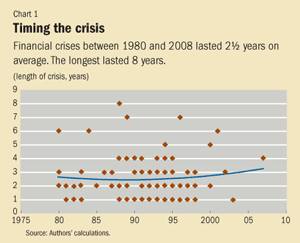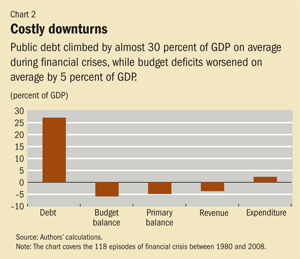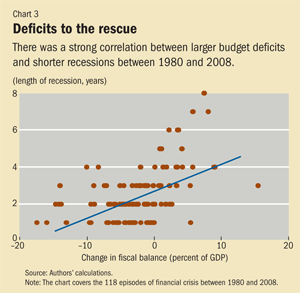Fiscal Expansions: What Works
Finance & Development, December 2009, Volume 46, Number 4
Emanuele Baldacci and Sanjeev Gupta
There is a firm link between the composition of fiscal policy and the length of a financial crisis
FISCAL measures, such as tax cuts and spending increases, have been central to government responses to the current global financial crisis.
The world’s biggest economies
The so-called Group of Twenty represents many of the world’s largest economies—advanced and emerging—and accounts for about 80 percent of global output and trade. The G-20, which includes 19 countries and the European Union, has become the main forum for major economies to discuss global economic conditions and what collective actions may be needed. The advanced economies in the G-20 are Australia, Canada, France, Germany, Italy, Japan, South Korea, the United Kingdom, and the United States. Emerging economy members are Argentina, Brazil, China, India, Indonesia, Mexico, Russia, Saudi Arabia, South Africa, and Turkey.
All countries in the Group of Twenty (G-20—see box) have adopted discretionary fiscal packages to fight the economic downturn that was set off in mid-2007 by a financial and banking crisis with roots in the U.S. mortgage market. Those programs, enacted specifically to boost aggregate demand during the economic downturn, cost about 2 percent of the gross domestic product (GDP) of the G-20 countries in 2009 and are projected at 1.6 percent of GDP in 2010 (IMF, 2009).
These expansionary fiscal policies have begun to offset the fall in private demand in G-20 countries, but it is too early to tell whether they will help shorten the duration of the recession and promote growth in the medium term. Does it matter for the next three to five years whether governments rely on tax cuts or spending increases to combat the recession? Or whether governments cut consumption taxes or income taxes or spend on current consumption or investment? We examine these questions, using historical data from past banking crises, which have caused more severe and protracted recessions than those with their roots in the real economy (Baldacci, Gupta, and Mulas-Granados, 2009).
Fiscal balances deteriorate
The discretionary programs enacted to combat the global recession contributed to increased government deficits. In addition, declining economic activity and a drop in asset values lowered government revenues and increased spending for existing social programs, such as unemployment insurance. On average, fiscal balances in the G-20 nations are projected to deteriorate by about 7 percent of GDP in 2009, compared with the precrisis period. The discretionary measures account for almost one-third of the increase in deficits. Discretionary fiscal stimulus was somewhat larger in emerging market economies, which have limited social programs and lower revenues. By contrast, in advanced G-20 economies, the bigger deficits were caused mainly by automatic increases in spending on such existing social programs as unemployment insurance and social assistance.
Most of the fiscal stimulus has involved raising public spending. More than two-thirds of the discretionary stimulus came in spending measures in 2009, with the rest in tax cuts. Investment in infrastructure accounts for almost half of the stimulus in emerging G-20 economies, compared with about one-fifth in advanced G-20 economies. Tax reductions, notably in corporate and personal income taxes, are a significant share of fiscal stimulus in advanced economies.
Recessions and fiscal policy
The role of fiscal and monetary policy during recessions has been studied extensively. Fiscal and monetary policies counter the effects of shrinking output during recessions, credit contractions, and asset price declines (Claessens, Kose, and Terrones, 2008). Fiscal policy appears to be particularly effective at shortening the duration of recessions. This suggests that an aggressive countercyclical fiscal stance—one that leans against the direction in which the economy is moving by cutting taxes or increasing spending—is appropriate during recessions and that fiscal stimulus should be large, sufficiently long lasting, diversified, contingent, collective, and sustainable (Spilimbergo and others, 2008). However, there is little evidence of the effectiveness of fiscal policy during periods of systemic banking crises. This has limited our understanding of how the current stimulus packages will affect the duration of the crisis.
Several factors could hamper the effectiveness of fiscal expansion during the more severe and long-lasting recessions caused by financial crises:
- The dramatic drop in aggregate demand necessitates a larger fiscal stimulus to support the economy than in a standard recession.
- The implementation of fiscal policy is made difficult because the ability of consumers to spend is hampered by financial distress. The latter causes capital markets to freeze, collateral to fall in value, and lenders to tighten loan standards—all of which limit the potential for private consumers to access credit against the backdrop of severe income losses.
- Governments find it difficult to finance fiscal expansions in a more risk-averse global environment. While this can be particularly important for countries with high initial levels of debt or high credit risk, an across-the-board increase in the perception that it is riskier to lend to governments can affect sovereign bond issuance even in better-rated economies. However, this effect can be offset in part by lower inflation pressures and financial markets’ flight to quality.
Systemic banking crises and fiscal policy
We used new data on financial crisis episodes compiled by Laeven and Valencia (2008) to study the effectiveness of fiscal policy under systemic banking crises. This database comprises 118 episodes of financial crisis that occurred in 99 countries during the period 1980–2008. These crises were different from standard recessions because they originated from severe systemic disruptions in the banking system. Financial crises are typically associated with bigger economic losses than in normal recessions: the output loss is 3 percent of GDP in recessions compared with more than 6 percent of GDP in financial crises.
 Financial crises lasted on average two and a half years (see Chart 1), with 85 percent of the episodes lasting between one and four years. The longest lasted eight years. These crises also generated large economic costs. The peak-to-trough fall in GDP growth was more than 5 percentage points during the average shock episode. The effects of crises on fiscal aggregates were also significant: during the crisis, public debt increased by about 30 percentage points of GDP (see Chart 2), reflecting a large deterioration in the primary fiscal balance. A drop in revenue collection as well as higher public
Financial crises lasted on average two and a half years (see Chart 1), with 85 percent of the episodes lasting between one and four years. The longest lasted eight years. These crises also generated large economic costs. The peak-to-trough fall in GDP growth was more than 5 percentage points during the average shock episode. The effects of crises on fiscal aggregates were also significant: during the crisis, public debt increased by about 30 percentage points of GDP (see Chart 2), reflecting a large deterioration in the primary fiscal balance. A drop in revenue collection as well as higher public  expenditure contributed to the fiscal deterioration. These results are similar to the estimated impact of the current crisis on output and government debt in G-20 countries and to those reported in other studies on financial crises (Reinhart and Rogoff, 2009).
expenditure contributed to the fiscal deterioration. These results are similar to the estimated impact of the current crisis on output and government debt in G-20 countries and to those reported in other studies on financial crises (Reinhart and Rogoff, 2009).
Did fiscal expansions help in shortening the length of financial crises? Our results, based on regression analysis of the factors that affected crisis duration, indicate that they did. Higher government spending and lower taxes boosted aggregate demand by replacing falling private consumption. Public investment also contributed to offsetting the collapse in private investment. Higher deficits led to shorter crisis durations in our sample (see Chart 3).  An increase of 1 percent of GDP in the fiscal deficit reduced the duration of the crisis by almost two months. This suggests that fiscal expansion of a size similar to that adopted on average by G-20 countries during the current global financial crisis may cut the length of the recession by almost one year, compared with a baseline scenario in which the budget deficits remain the same as in the precrisis period.
An increase of 1 percent of GDP in the fiscal deficit reduced the duration of the crisis by almost two months. This suggests that fiscal expansion of a size similar to that adopted on average by G-20 countries during the current global financial crisis may cut the length of the recession by almost one year, compared with a baseline scenario in which the budget deficits remain the same as in the precrisis period.
Fiscal policy composition
We also find that the composition of fiscal expansion—how it is distributed as current spending, investment spending, or tax cuts—matters. Higher public consumption—government purchases of goods and services and wages—and lower income taxes shorten the duration of financial crises. For example, a 10 percent increase in the share of public consumption in the budget reduced the crisis length by three to four months more than larger fiscal deficits alone would have. The same cannot be said for capital expenditures. Why? We believe that implementing capital projects generally takes longer than directly injecting demand through government purchases of goods and services. This picture seems consistent with the pace of disbursement of current fiscal packages. Tax cuts and increases in government consumption and transfers were implemented rapidly in many G-20 economies. However, procedures for budget allocation, transfers to subnational governments, procurement, and payments to contractors slowed down the disbursement of some capital projects (Horton, Kumar, and Mauro, 2009).
The composition of tax measures is also important: cutting consumption taxes was more effective than cutting income taxes. That is because cuts in levies such as value-added or sales taxes quickly stimulate private consumption, whereas income tax reductions can in part be saved. Consumption tax cuts help support domestic demand, particularly when dropping asset values, income losses, and rising unemployment dent households’ ability to spend.
Other factors played a significant role. Crises that were preceded by a credit boom tended to last longer. Those during which a guarantee for bank deposits was provided (or expanded) by the government were shorter than crises during which governments did not provide this financial safety net. Closing failed banks and strong government intervention in financial markets were also beneficial in resolving crises.
The analysis also found that the way fiscal policy is constructed affects whether it creates conditions that promote economic growth five years after a crisis. Fiscal responses that had a greater share of public investment may not have helped shorten recessions as much as consumption spending, but they had a positive effect on output growth in the medium term. A 1 percent increase in the share of capital outlays in the budget raised postcrisis growth by about one-third of 1 percent a year in our regression analysis of crisis episodes. It appears that capital investment promotes medium-term growth by removing infrastructure bottlenecks and by enhancing private sector competitiveness. Income tax reductions were also associated with positive growth effects. Trimming income taxes removed distortions that hurt long-term economic performance.
These results highlight the potential trade-off between fiscal policy’s role in supporting aggregate demand in the short term and its contribution to productivity growth in the medium term. They point to the need to evaluate the composition of fiscal stimulus packages before their implementation, as different short-term and medium-term fiscal multipliers can affect fiscal policy performance during the crisis and in its aftermath.
Fiscal policy and debt sustainability
However, insufficient fiscal space—that is, the capacity to spend more without jeopardizing fiscal solvency—and concerns about the sustainability of public debt can limit the effectiveness of fiscal expansions during crises. The lack of fiscal space in countries with high public sector debt–to-GDP ratios before the crisis not only constrains the government’s ability to implement countercyclical policies, it also undermines the effectiveness of fiscal stimulus and the quality of fiscal performance. For example, in countries with relatively high debt, crises lasted almost one year longer; the beneficial effects of fiscal expansions were negated by the high public debt. Our simulations show that high initial levels of public debt make it more difficult to exit a crisis and limit the ability of expansionary fiscal policy to support output growth. Similar results are found for countries with lower per capita income, because those nations’ limited fiscal space, lower technical capacity to implement fiscal stimulus plans, and higher exposure to macroeconomic risks—including to external shocks—reduce the scope and the effects of fiscal expansions during crises.
References
Baldacci, Emanuele, Sanjeev Gupta, and Carlos Mulas-Granados, 2009, “How Effective Is Fiscal Policy Response in Systemic Banking Crises?” IMF Working Paper 09/160 (Washington: International Monetary Fund).
Claessens, Stijn, M. Ayhan Kose, and Marco Terrones, 2008, “What Happens During Recessions, Crunches, and Busts?” IMF Working Paper 08/274 (Washington: International Monetary Fund).
Horton, Mark, Manmohan Kumar, and Paolo Mauro, 2009, “The State of Public Finances: A Cross-Country Fiscal Monitor,” IMF Staff Position Note 09/21 (Washington).
International Monetary Fund (IMF), 2009, “The State of Public Finances: A Cross-Country Fiscal Monitor,” IMF Staff Position Note 09/25 (Washington: International Monetary Fund).
Laeven, Luc, and Fabian Valencia, 2008, “Systemic Banking Crises: A New Database,” IMF Working Paper 08/224 (Washington: International Monetary Fund).
Reinhart, Carmen, and Kenneth Rogoff, 2009, “The Aftermath of Financial Crises” NBER Working Paper 14656 (Cambridge, Massachusetts: National Bureau of Economic Research).
Spilimbergo, Antonio, Steve Symansky, Olivier Blanchard, and Carlo Cottarelli, 2008, “Fiscal Policy for the Crisis,” IMF Staff Position Note 08/01 (Washington: International Monetary Fund).
Emanuele Baldacci is a Deputy Division Chief and Sanjeev Gupta is Deputy Director in the IMF’s Fiscal Affairs Department.


